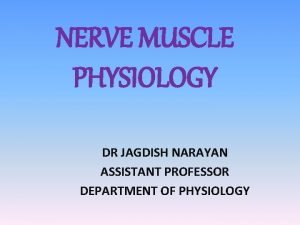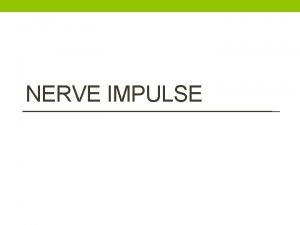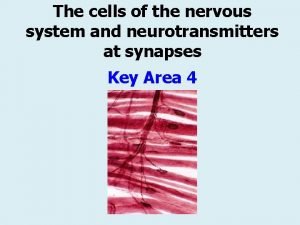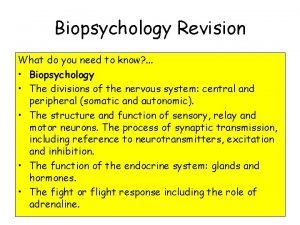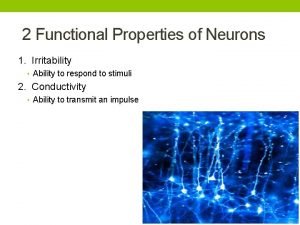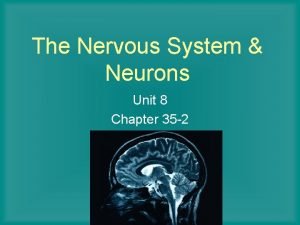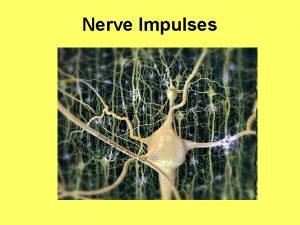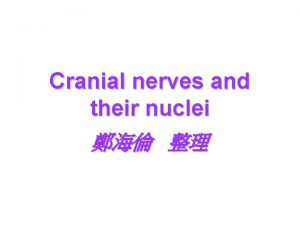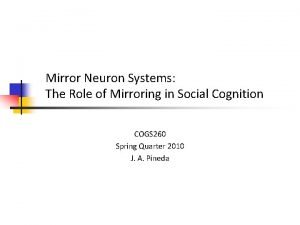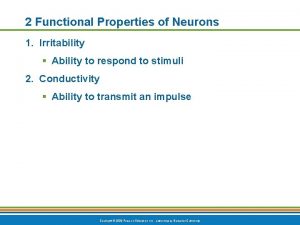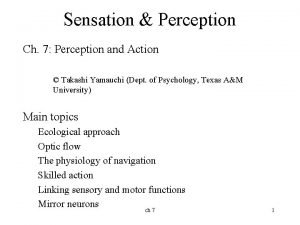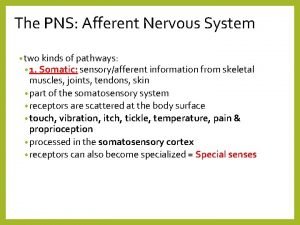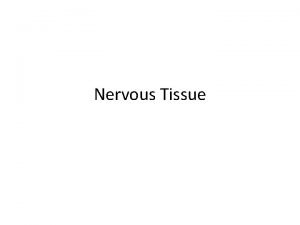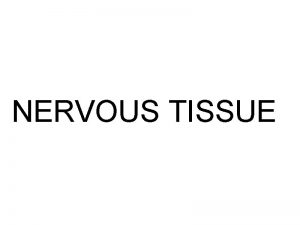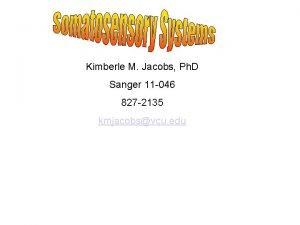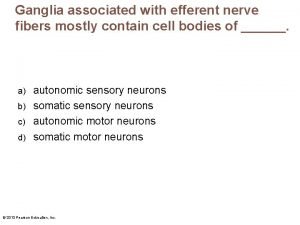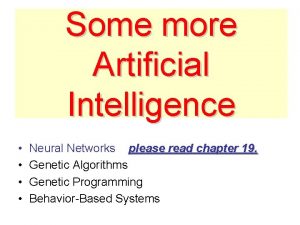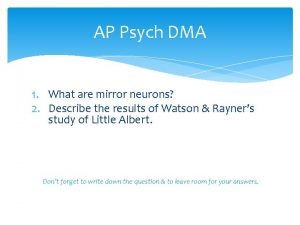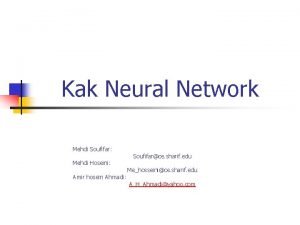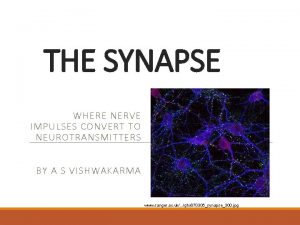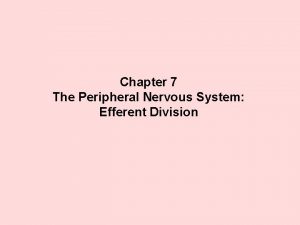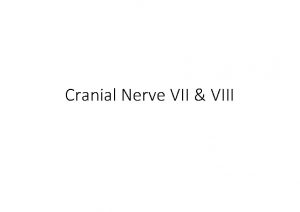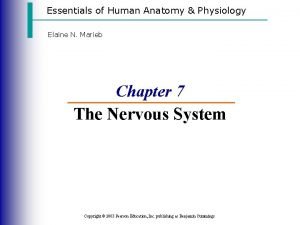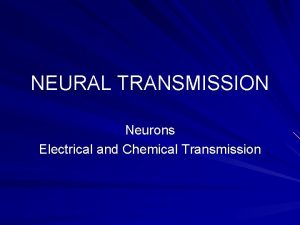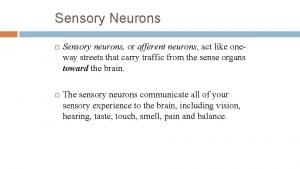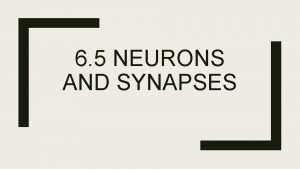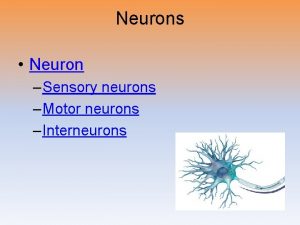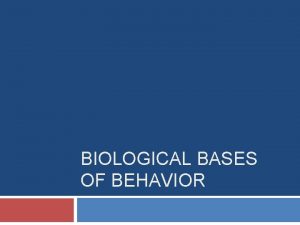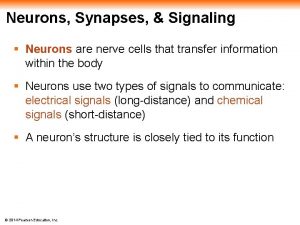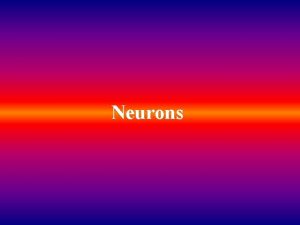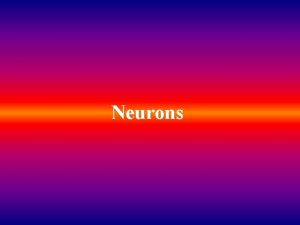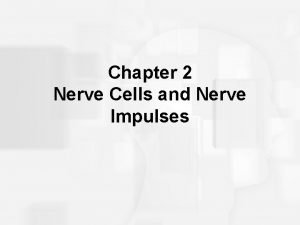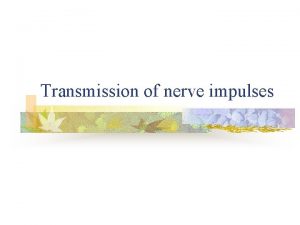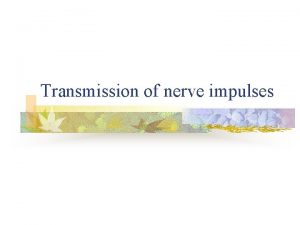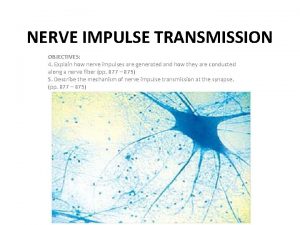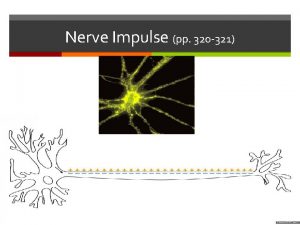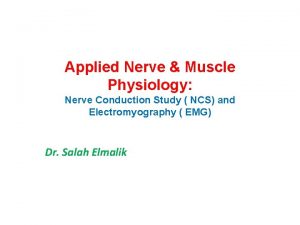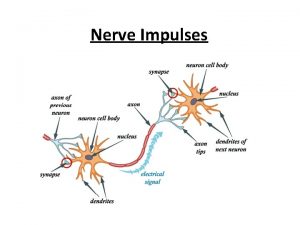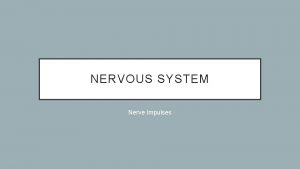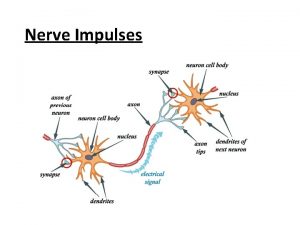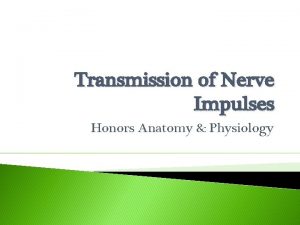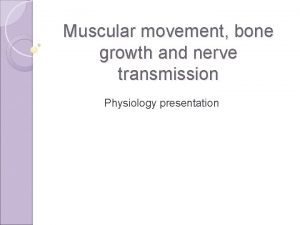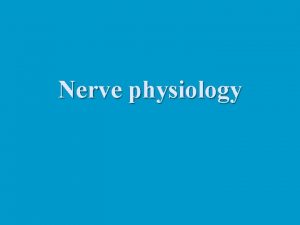Physiology of Nerve Transmission How do neurons do
































- Slides: 32

Physiology of Nerve Transmission How do neurons do their job?

NERVE IMPULSES The function of a neuron is to transmit information from one part of the body to another. How does this happen?

NERVE IMPULSES A. No mitosis occurs in neurons. However, if the cell body is intact, the axon is in the PNS, AND the neuron has a myelin sheath, there is a chance for some repair.

NERVE IMPULSES B. Rate of transmission: How fast are nerve impulses? ◦ 1. A fibers ◦ 2. B fibers ◦ 3. C fibers

NERVE IMPULSES Nature of nerve transmission: Electrochemical - why? ? C.

NERVE IMPULSES* D. Similarities to Muscle Contraction: Electrochemical All-or-none Polarization Depolarization Action potential Repolarization Threshold stimulus Use ATP Latent period Summation Calcium needed Neurotransmitters Refractory period Excitability Sodium-Potassium pump * Pick any 4 that will be easy for you to remember.

NERVE IMPULSES E. Nerve transmission ◦ 1. Resting membrane potential: -70 m. V membranes are polarized Na+ outside and K + inside Outside is positively charged; Inside is negatively charged

NERVE IMPULSES Role of the sodium-potassium pump Maintains resting membrane potential (polarization) by pumping 3 sodium out and 2 potassium into the cell. (active transport - ATP needed) This keeps the cell membrane polarized & is necessary for repolarization.


NERVE IMPULSES 2. Stimulus Depolarization Resting potential goes from -70 m. V to 0 m. V Na+ ions rush into cell & K + rush out Chain reaction along axon to create an impulse

NERVE IMPULSES Action potential = nerve impulse ◦ Travels along surface of axon ◦ Nodes of Ranvier increase rate by saltatory conduction ◦ Impulse jumps across nodes

Saltatory conduction http: //staff. washington. edu/cdave/pbio 505/Week 2 Presentation. xml

NERVE IMPULSES 3. Repolarization ◦ Occurs within 0. 001 sec (1 millisecond) ◦ Resting membrane potential (polarization) restored by sodiumpotassium pump.

Review Questions What is meant by “reaching the threshold”? Why is the sodium-potassium pump necessary? How many Na+ are pumped out of the cell? How many K+?

Action Potential tutorial Click on the link below and then use the Action Potential animation before going on. http: //outreach. mcb. harvard. edu/animations. htm

NERVE IMPULSES Propagation of an action potential: There are 3 stages. ◦ 1. ◦ 2. ◦ 3.


NERVE IMPULSES 4. Refractory period: Occurs during depolarization: 2 types Absolute - NO new impulse (action potential) can be generated Relative - after absolute, second A. P. can be generated if stimulus is ABOVE threshold (suprathreshold stimulus)

ACTION POTENTIAL ANIMATION http: //www. dnatube. com/video/1105/Understanding. Action-Potential-and-Nerve-Impulses GO THROUGH THIS ANIMATION BEFORE CONTINUING WITH THIS PRESENTATION.

NERVE IMPULSES F. Summation - group of subthreshold stimuli act together to reach threshold level so the neuron “fires”

Review Questions What is the refractory period and when does it occur? Explain the differences between the absolute and relative refractory periods. Why is summation necessary?

NERVE IMPULSES How does a nerve impulse get from one neuron to another? ◦ 1. Synapse ◦ 2. Neurotransmitter ◦ 3. Synaptic transmission

Nerve Impulse Transmission G. Synaptic transmission - What happens to the action potential once it reaches the end of the axon? Synapse (synaptic cleft)- gap between axon & dendrite of neurons

Nerve Impulse Transmission G. Synaptic transmission 1. Impulse reaches end of axon. Calcium ions enter axon bulb. Vesicles release neurotransmitters into synaptic cleft. 2. Receptor sites on dendrites absorb neurotransmitters & new A. P. is produced. (depolarization)


http: //staff. washington. edu/cdave/pbio 505/Week 2 Presentation. xml

Synaptic transmission Click on the link below and then use the Synaptic Transmission animation before going on. http: //outreach. mcb. harvard. edu/animations. ht m

NERVE IMPULSES H. Types of synaptic transmission: ◦ 1. Excitatory Lowers threshold, easier to depolarize membrane, weaker stimulus works Examples: ACh, adrenalin (epinephrine), serotonin, dopamine, histamine

NERVE IMPULSES H. Types of synaptic transmission: ◦ 1. Inhibitory Raises threshold, harder to depolarize membrane, inhibits transmission of impulse Examples: ACh, GABA, glycine, noradrenalin (norepinephrine), glutamate

NERVE IMPULSES Neurotransmitters have very short-lived effects because they are in the synaptic cleft for a very short time. Three things can happen: 1. absorbed by receptors on dendrites 2. reabsorbed by axon 3. destroyed before reaching receptors on dendrites

Action Potential Animations GO TO THIS WEBSITE: http: //brainu. org/movies

 Nerve muscle physiology
Nerve muscle physiology Nerve impulse steps with pictures
Nerve impulse steps with pictures Nerve impulse transmission
Nerve impulse transmission Three types of neurons
Three types of neurons Nerve signal transmission steps
Nerve signal transmission steps Nerve impulse transmission steps
Nerve impulse transmission steps Nerve impulse transmission steps
Nerve impulse transmission steps Trigeminal nerve which cranial nerve
Trigeminal nerve which cranial nerve Mirroring 260
Mirroring 260 Irritability of neurons
Irritability of neurons Balint syndrome
Balint syndrome Upper motor neurons
Upper motor neurons Type 1 cutaneous mechanoreceptors
Type 1 cutaneous mechanoreceptors Nervous tissue
Nervous tissue Neuroglial cell
Neuroglial cell Fourth order neurons
Fourth order neurons Ganglia associated with efferent fibers
Ganglia associated with efferent fibers What is language
What is language Nervous system flow chart
Nervous system flow chart Input neurons
Input neurons Sensory modality examples
Sensory modality examples Mirror neurons ap psych
Mirror neurons ap psych Input neurons
Input neurons Functional classification of neurons
Functional classification of neurons Neurons
Neurons Homunculus
Homunculus Processes of a neuron
Processes of a neuron Efferent motor neurons
Efferent motor neurons Vestibulocochlear nerve.
Vestibulocochlear nerve. Diagram of a neuron
Diagram of a neuron Stretch reflex
Stretch reflex Mirror neurons
Mirror neurons Pruning neurons
Pruning neurons
